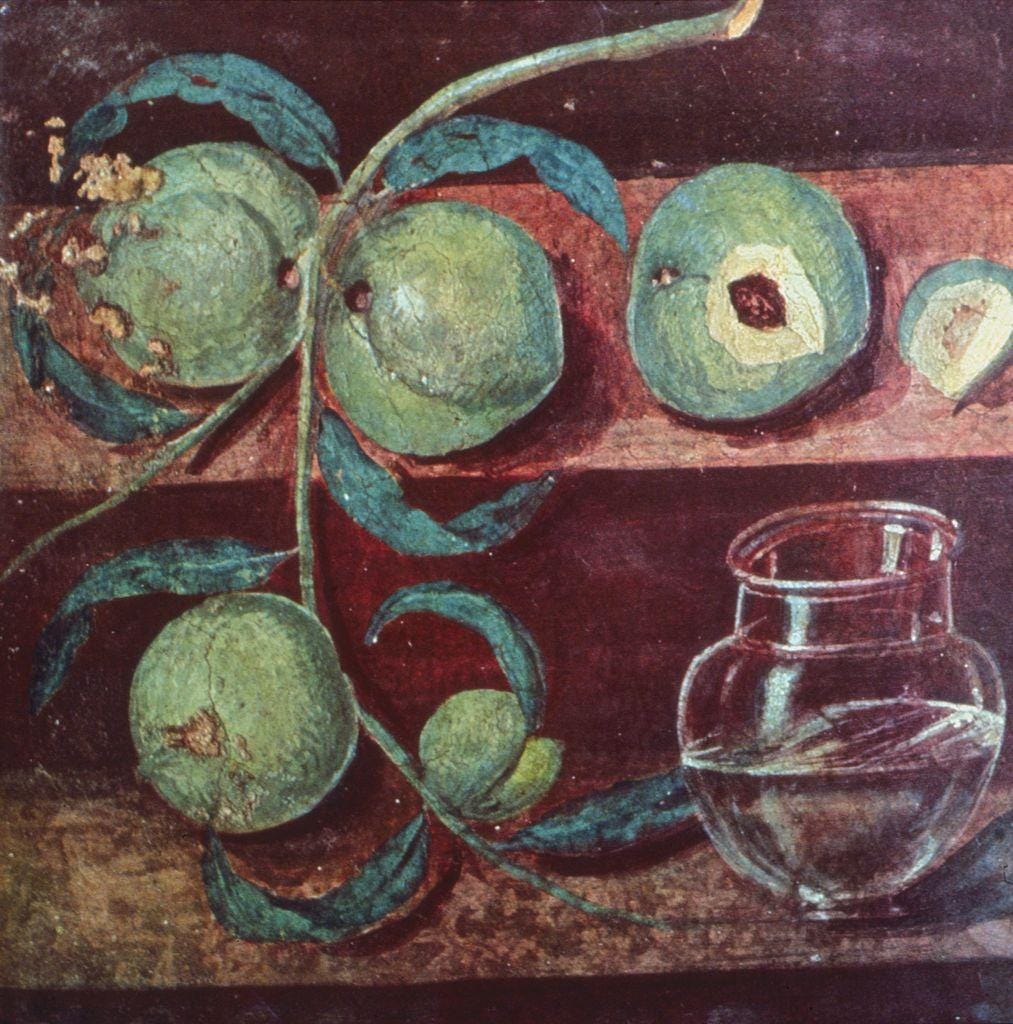
One of the most universally accessible themes taken up by visual artists, still life has remained popular in Western art from ancient times to the present. Its popularity is one reason I have been considering still life as a subject for Chance Encounters since we began publishing last year. When planning this week’s edition, I discovered that there are currently three exhibitions focusing on still life (listed below), so it seemed that the time is right for this look at still life, past and present.
A still life is an arrangement of inanimate objects, chosen and arranged by the artist based on aesthetic and/or symbolic qualities. Such compositions are found among Ancient Egyptian tomb paintings which allowed depicted objects to be available to the deceased in the afterlife. Though few Ancient Greek paintings survive, written accounts describe the realism with which Greek painters depicted ordinary objects like food and fabrics. Following the Greek tradition of illusions, Ancient Roman artists also strove for convincing naturalism. In the example above, the unnamed fresco painter depicted yellow-green peaches against an orange-red wall. The color contrast is eye-catching as is the artist’s effort to capture the glass vessel containing clear liquid. For the wealthy homeowner who commissioned a fresco like this, the ability of the artist to capture believable depictions would bring praise to the patron and convey to the visitor that their host appreciated fine things and was able to provide them a lavish experience of food and drink, as well as of art.
Though still life elements were incorporated into religious art and portraiture in Medieval and early Renaissance art, it was not until the Baroque period (the 17th century) that the theme of still life really flourished. In Holland especially, still life paintings celebrated the wonderful imported objects and foods that brought wealth to the nation and to the individuals who purchased such art. At the same time, the taste for extreme illusionism, and the market for paintings that exhibited it, led to artists who specialized in painting still life generally, or even more specifically, in flowers, in arrangements of game and meat, or in tablescapes piled with food and serving dishes. Masterpieces of seventeenth century still life continue to draw the attention of contemporary artists who use the inspiration of their predecessors’ work to address more contemporary concerns.
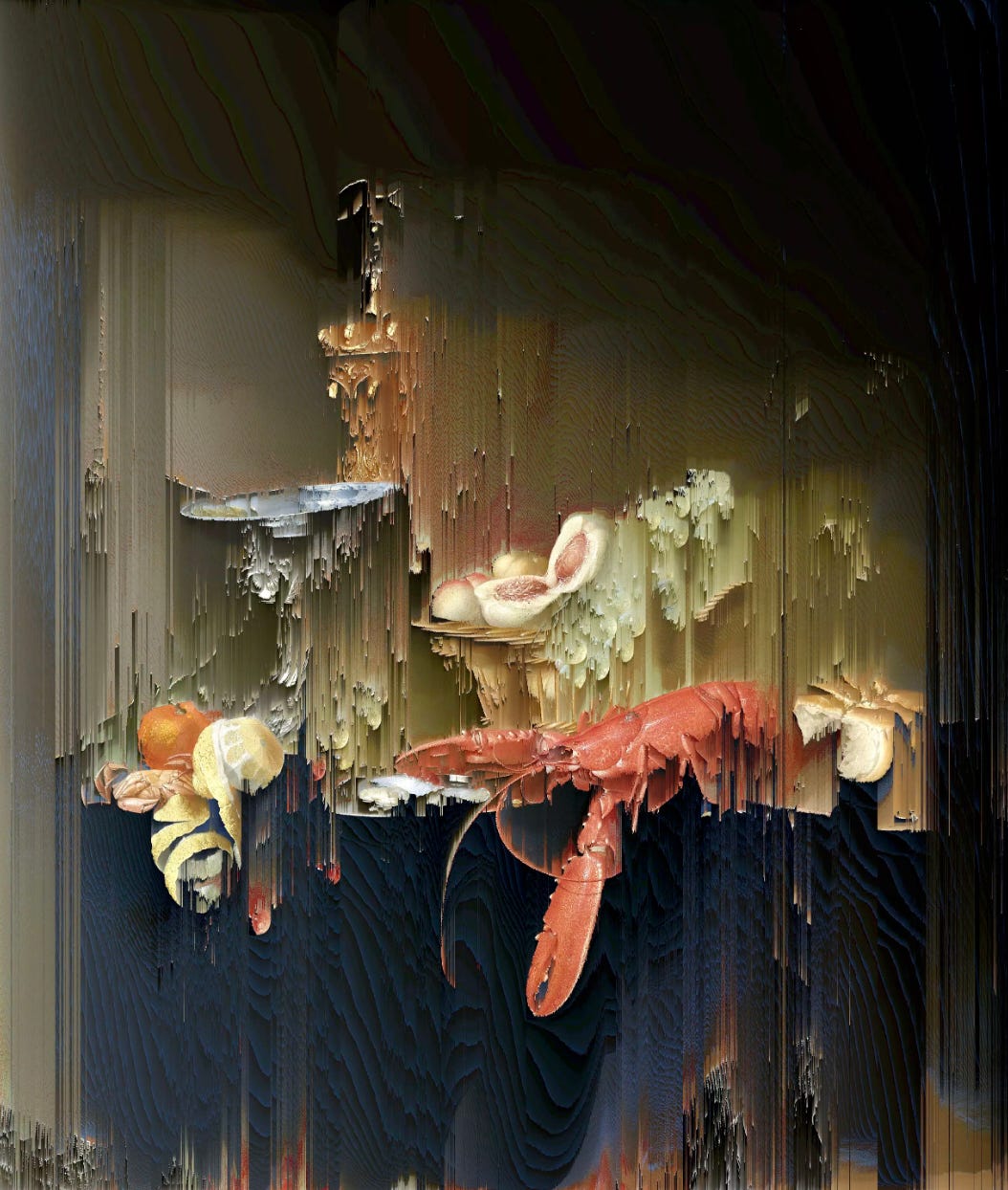
A British artist of Chinese descent, Gordon Cheung (b. 1975) uses the still life tradition to critique past socioeconomic systems and modern capitalism. In a series of digital prints based on the lush still lifes of 17th century Holland, Cheung distorts the image using a computer program. The result is an image that still contains many of the recognizable details of the source but appears to be dissolving before our eyes. Just as the culture and values that produced the original painting have been altered or erased by changes in society, so the symbolism and aesthetic qualities of the original painting have been changed by the glitches introduced by the program Cheung used.
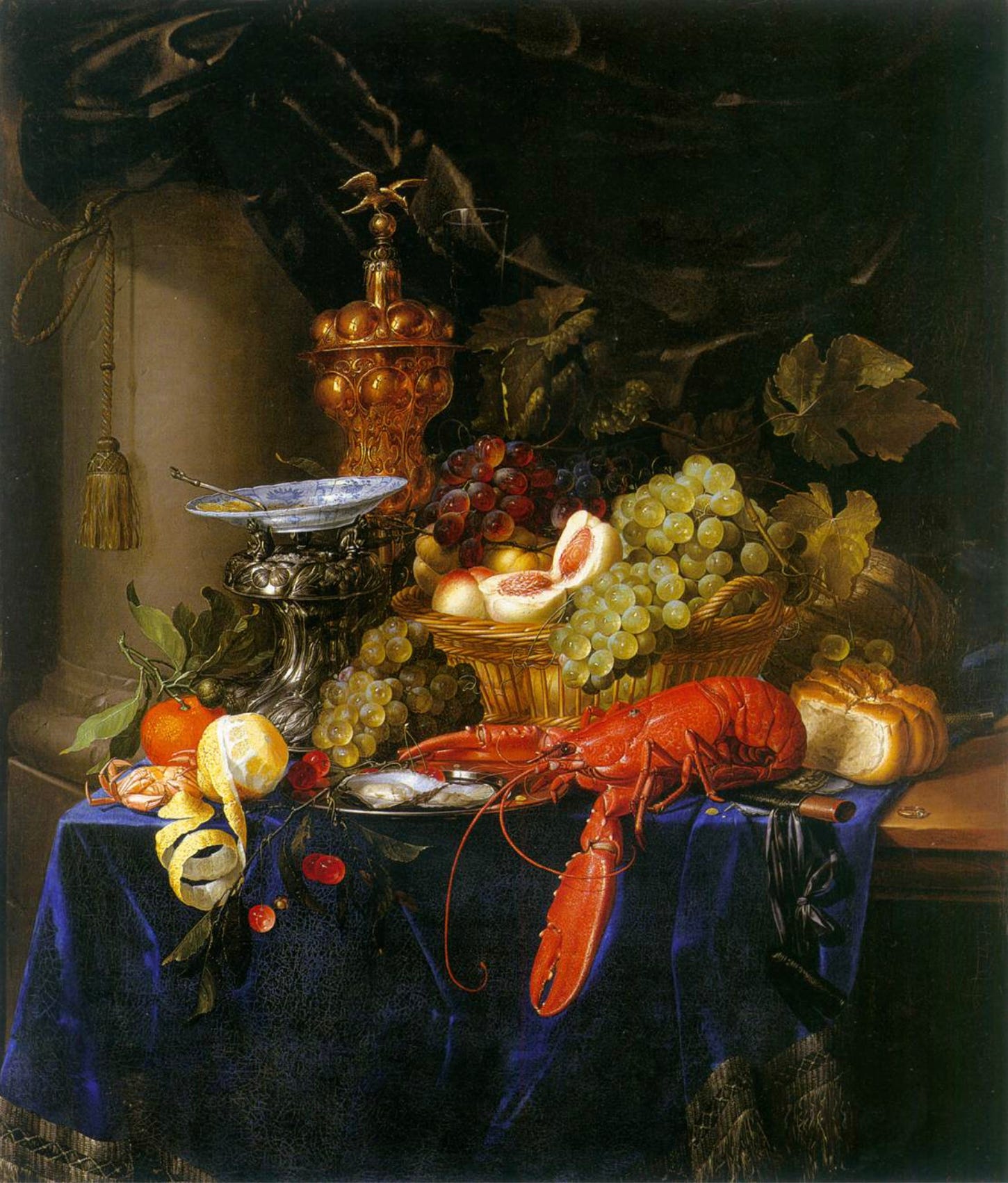
In Cheung’s source image, Pieter de Ring’s mid-17th century Still Life with Golden Goblet, many signs of wealth and luxury are bathed in warm light. The bright red of the cooked lobster and the vivid yellow of the peeled lemon draw our eyes into the mass of fruit and seafood; the whole is designed to direct our attention to the large golden vessel behind the pile of food. There’s nothing subtle about the wealth on display. At the same time, the artist flaunts his skill with color, texture, and illusionistic depth. In contrast, Cheung’s image not only appears to be dripping down the surface, its colors are draining away, and the illusionist textures are disappearing too. The shadow that pushed de Ring’s objects toward us seems to crawl down Cheung’s work, following the streaky texture, as if it too will consume the older painting’s luxuries.

From the 17th and into the 19th century, still life remained popular with artists and buyers but the increasingly powerful art academies and associated art theorists established a hierarchy of subject matter that placed still life at the bottom. This system valued artists who could create history paintings, large paintings containing many figures; these would be scenes of history, mythology, and religion, preferably with a moral lesson to be taught. Portrait painting, since it involved depicting human figures, was second in rank, followed by genre painting (scenes of everyday life), landscape, animal painting, and still life in that order. However, in the 19th century, as the patronage for art moved away from the Catholic Church and the traditional aristocracy, wealthy urban buyers wanted paintings with more familiar and comprehensible themes. Landscape, genre subjects, and still life were more popular than ever with buyers and by the late 19th century these themes dominated among both traditionalist and avant garde artists.
Paul Cézanne (French, 1839-1906) was part of the generation of artists who followed the Impressionists (see Chance Encounters 30 Impressionism Begins). Cézanne followed the Impressionists in stressing landscape and still life in his work, but where they sought to record the transitory effects of light and atmosphere on their perception of reality, Cézanne was interested capturing the permanence and unity of nature. Still Life with a Ginger Jar and Eggplants is characteristic of the artist’s still life compositions in its combining of fruit, glass and ceramic vessels, and heavy fabrics. The other component of this composition is a yellowish table which contrasts in its color and rectangular shapes with the predominantly blue and green curved forms in the foreground. Cézanne used color to tie his paintings together; here, the yellows and oranges of the small fruits reappear in the table while the green of the large vessel and melon show up in the folds of the light-colored cloth and the wall under the table. Even the purple tones of the eggplants are echoed in patches on the cloth, the walls, and the blue pot. Cézanne is regarded as an important influence by later Modern and Contemporary artists and his commitment to still life as a means of conveying an artistic philosophy was part of his impact.

The most immediate influence of Cézanne’s work was on Cubism, the movement founded by Pablo Picasso (Spanish, 1881-1973) and George Braque (French, 1882-1963) in the first decades of the 20th century. Cézanne’s practice of representing objects with small blocks of color helped to inspire the early phase of Analytical Cubism. (See Chance Encounters 11, Picasso: The Cubist Revolution.) Because the Cubists were engaged in an experimental approach to the depiction of space, they preferred subjects like single figures and still life, which allowed them to build their picture space out of interlocking planes. In Violin and Playing Cards on a Table by Juan Gris (Spanish, 1887-1927), the artist depicts musical instruments in fractured planes of color and pattern. This method of distinguishing among the planes marks this painting as part of the Synthetic Cubist phase. Gris’ bold contrasts of color and shape create depth and energy in this painting and helped make him an important figure in the development of Cubism.

Giorgio Morandi (Italian, 1890-1964) is known for his paintings and etchings. Though he also painted landscapes, his representations of collections of bottles and tableware described through subtle tonal variations are his best known works.
What interests me most is expressing what's in nature, in the visible world, that is. – Giorgio Morandi
The 1944 Still Life reproduced above stands out because of the blue and yellow shape in the foreground and the grayish green background which is a blend of those two pale tones. Only among Morandi’s restrained color schemes would these delicate colors be considered striking, but they seem bold in comparison to the three creamy containers and the whiter bowl at the right. This small painting, only 12 inches tall, manages to convey that these pale, ordinary objects are worthy of the artist’s attention and careful depiction, and are thus also worthy of our close observation.

Very different characteristics are featured in Five Spot by the Photorealist painter Ralph Goings (American, 1928-2016). This brightly colored arrangement of shiny objects is characteristic of the artist’s interest in depicting familiar slices of American life. Goings was interested in the subject matter chosen by Pop Artists but disappointed in the lack of photographic realism in their style. He decided that copying from projected photographs would allow him to achieve the appearance he preferred.
… some people were upset by what I was doing and said “it's not art, it can't possibly be art”. That gave me encouragement in a perverse way, because I was delighted to be doing something that was really upsetting people… – Ralph Goings
This painting takes its title from the logo on the red menu tucked behind the napkin dispenser. When we notice that the red color appears again behind the flowers and the sugar dispenser, we’re reminded that, in spite of its photographic realism, this is an artist’s creation, a still life that the painter set up to create a visually interesting composition for our appreciation.
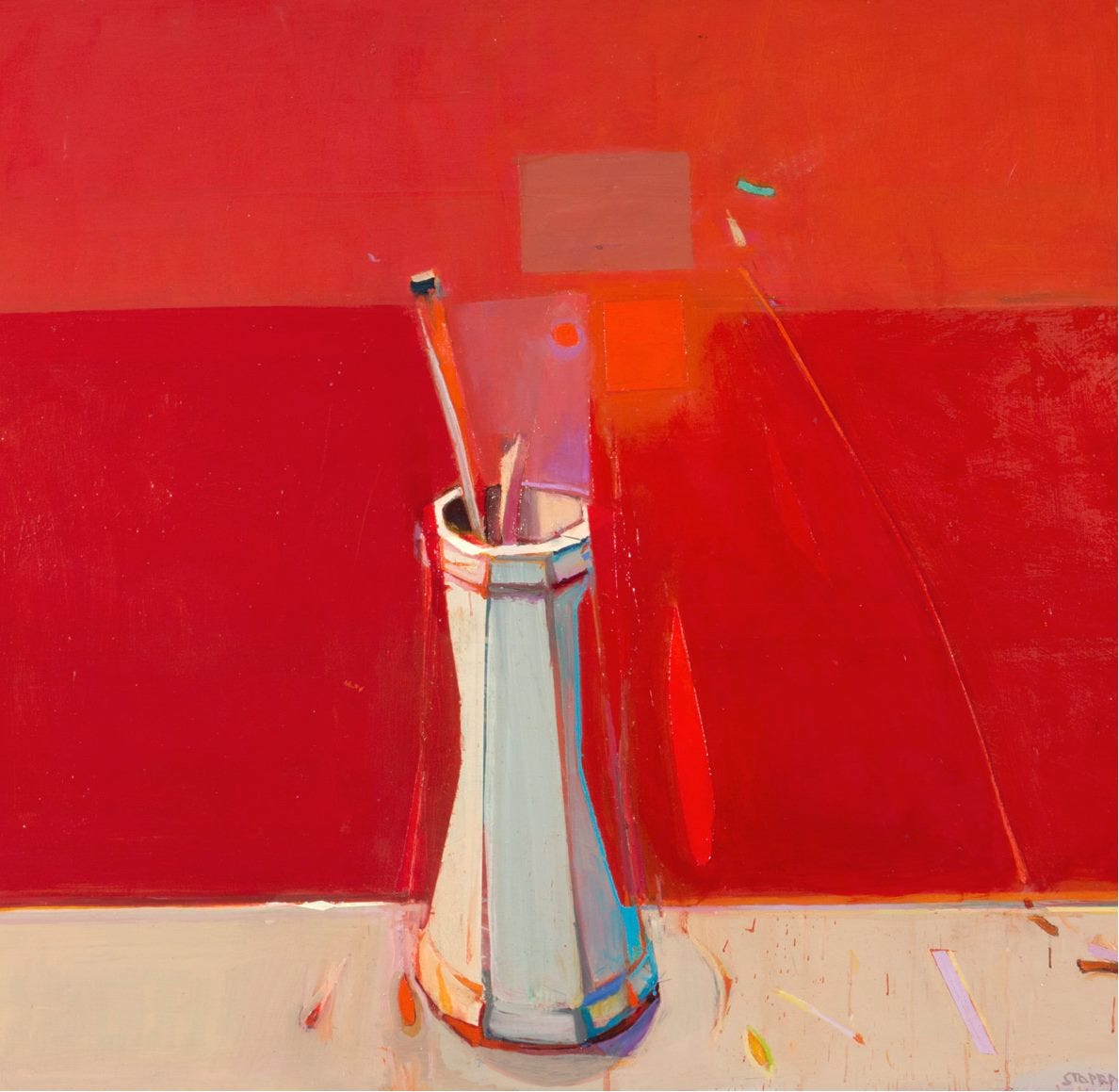
Raimonds Staprans (Latvian-American, b. 1926) also uses the color red to unify his still life Tall Flower, but where Goings started from a photograph of his subject, Staprans set up a very simple still life as the basis for an abstract representation. This artist is known for using his compositions to consider the geometric and color relationships of objects in space. In this, many observers see a similarity to Cézanne’s approach. In this example, we can see how shapes and strokes in different red tones are arrayed around the central white vase, while streaks and flecks of yellow, turquoise, and white appear throughout the painting, enlivening an otherwise very simple composition. Staprans is also an accomplished playwright in his native Latvia where he was awarded the country’s highest civilian award, The Order of the Three Stars.
Ori Gersht (Israeli-British, b. 1967) is a photographer and filmmaker whose works explore relationships between life and death, violence and beauty. Pomegranate – Off Balance captures the moment when a bullet pierces the hanging fruit. To create this work, the artist set up a still life based on Still Life with Quince, Cabbage, Melon and Cucumber by Juan Sánchez Cotán (Spanish, 1560-1627). Sánchez Cotán’s still lifes, of which seven are known, are unusual for his period; the artist depicted a deep window-like frame in front of a black backdrop with some objects suspended by strings and others resting on the painted frame.

Where the Spanish artist was seeking precise balance, the photographer was disrupting the balance through destructive violence. Gersht chose a pomegranate instead of a quince because his plan was to film a bullet fired through the hanging fruit and a pomegranate explodes into a cascade of blood-red seeds, increasing the dramatic impact of the bullet. The film (below) captured the bullet at 1600 frames per second, far faster than the human eye can perceive. As a result, both the film and the still photograph capture something we couldn’t see without the photographer’s intervention.
Excerpt of Ori Gersht, Pomegranate, 2006. 3:52 minute HD film in color, with sound for framed LCD. The Jewish Museum, New York, New York, USA. © Ori Gersht.

The final work in this very brief survey of still life art is a recent work by Alison Elizabeth Taylor (American, b. 1972). The artist employs a unique combination of the traditional marquetry (inlaid wood images), painting, and collage.
The natural beauty inherent in finished wood draws attention to themes more subtle or complex. The splendor of the shellacked wood is an invitation to look at subjects the viewer might otherwise ignore. – Alison Elizabeth Taylor
In Hercules and Diomedes, Taylor depicted a figurine of the ancient hero defeating King Diomedes of Thrace as part of one of his Twelve Labors. The figurine duplicates one of a series of Renaissance sculptures by Vincenzo de’ Rossi (Italian, 1525-1587). The figurine shares its shelf with books of Classical literature and mythology. A shelf above holds two other souvenirs, including one from Caesar’s Palace in Las Vegas, a humorous juxtaposition apparent only to the attentive observer.
Still life allows artists to convey a wide variety of messages in an equally wide variety of styles. In this small selection of examples, I included works that demonstrate the flexibility still life offers to Modern and Contemporary artists but I really only scratched the surface of this rich form of artistic expression. Do you have a favorite still life image or artist? If so, please share it with us in a comment. What appeals to you in the work?
Thanks for reading. Come back next week for another edition of Chance Encounters.
Current exhibitions focused on the still life theme:
“The Superfluity of Things,” James Cohan Gallery, 52 Walker Street, 2nd Floor, New York, NY 10013, until October 19, 2024. https://www.jamescohan.com/exhibitions/2
“The Shape of Things: Still Life in Britain,” Pallant House Gallery, 9 North Pallant, Chichester PO19 1TJ, United Kingdom, until October 20, 2024. https://pallant.org.uk/whats-on/the-shape-of-things-still-life-in-britain/
“Die Schönheit der Dinge: Stillleben den 1900 bis heute (The Beauty of Things: Still Life from 1900 to Today),” Kunsthalle Emden, Hinter dem Rahmen 13, 26721 Emden, Germany, until November 10, 2024. https://kunsthalle-emden.de/ausstellungen/aktuelle-ausstellung




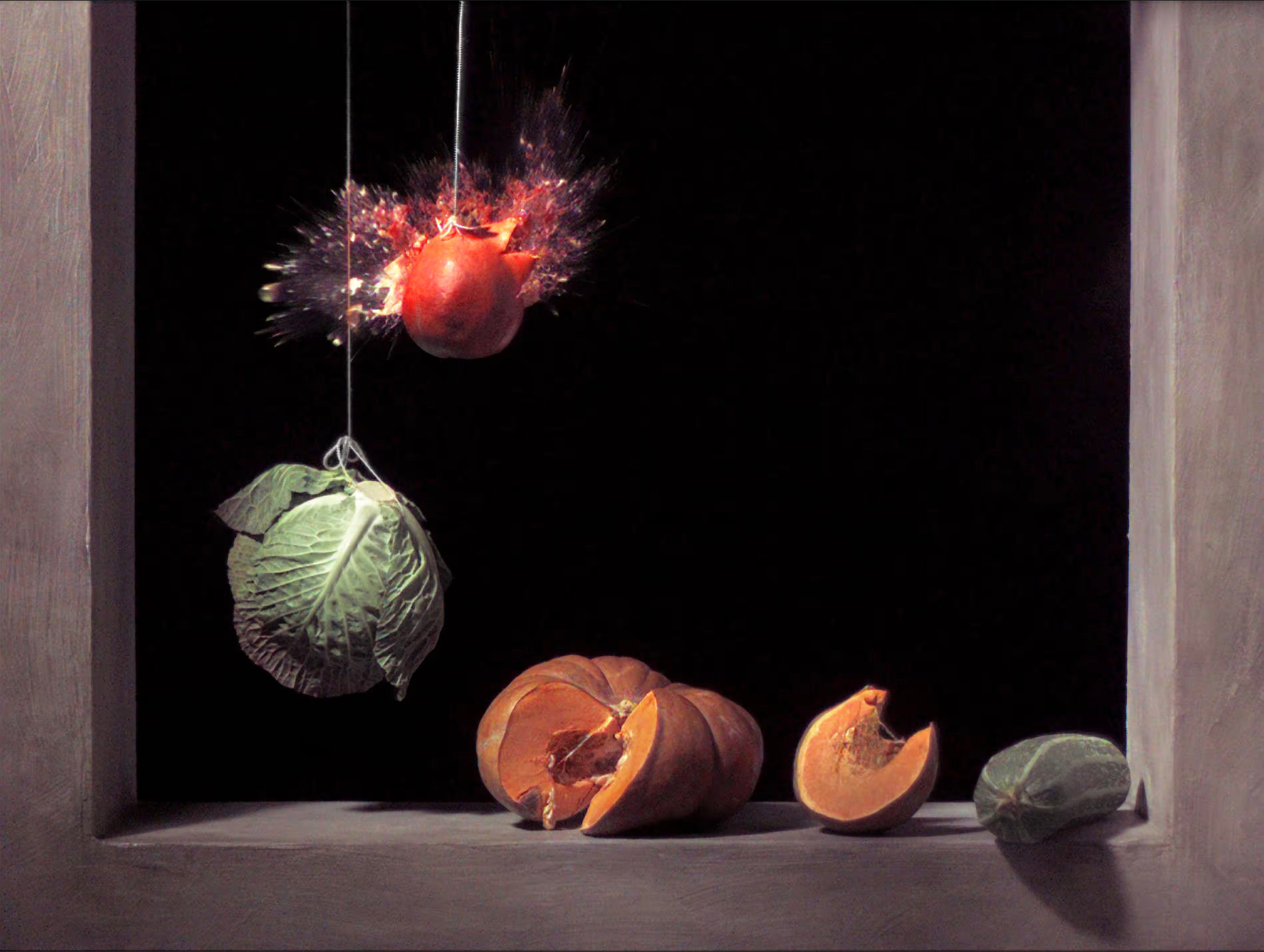
As you already knew I loved this weeks post. I was fascinated by the very early work. Thanks for sharing this with us.
Such a marvelous variety of examples of still life painting—and your commentary, as always, leads one so much deeper into the skill with which they are composed. I particularly enjoyed your guide through the use of color in the Cezanne. The ginger jar is such an appealing object in his hands—and I seem to recall he has a few paintings featuring these. Yet as much as I’ve admired them, I did not see the use of colors that you’ve pointed out, making the experience so much richer. As for still life paintings that are favorites, it is impossible to choose, but I will point to three. First is a painting I came upon in the Vassar Art Gallery that I found transfixing every time I viewed it: Trompe l'oeil Still-Life of a Letter Rack
DATENd
ATTRIBUTED TO Domenico Remps (Italian / German, c. 1620–1699) https://emuseum.vassar.edu/objects/6383/trompe-loeil-stilllife-of-a-letter-rack?ctx=1cc4cf07d92154bc80b314ad3370de21f50a9721&idx=2#
I was also delighted to discover still lifes by Van Gogh of the homeliest of objects. Here’s Still Life with Potatoes https://krollermuller.nl/en/vincent-van-gogh-still-life-with-potatoes, and here’s Still Life with French Novels and a Rose https://arthur.io/art/vincent-van-gogh/romans-parisiens-still-life-with-french-novels-and-a-rose
Thank you so much for another enthralling art-filled journey.